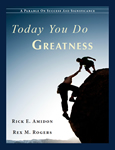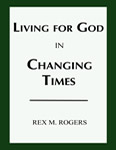The Ark Encounter, a life-size replication of the biblical Noah’s Ark, is a wonder to behold.
Hi, I’m Rex Rogers and this is episode #231 of Discerning What Is Best, a podcast applying unchanging biblical principles in a rapidly changing world, and a Christian worldview to current issues and everyday life.
The Ark Encounter, located on 800 beautiful rolling and wooded acres just off I-75 in Williamstown, Kentucky, opened in 2016, is truly impressive.
This Noah’s ark replication is the brainchild and work of prolific Australian Christian author and speaker, Ken Ham, who with two others founded Answers in Genesis and then developed the Creation Museum, opened in 2007 in nearby Petersburg, KY. According to Wikipedia’s snarky description, Ken Ham’s Answers in Genesis “advocates young Earth creationism on the basis of its literal, historical-grammatical interpretation of the Book of Genesis and the Bible as a whole. Out of belief in biblical inerrancy, it rejects the results of scientific investigations that contradict their view of the Genesis creation narrative and instead supports pseudoscientific creation science. The organization sees evolution as incompatible with the Bible and believes anything other than the young Earth view is a compromise on the principle of biblical inerrancy.” In other words, the people who wrote this piece for Wikipedia go with the evolutionary, old earth, i.e., billions of years, anti-Creation evolutionary theory that has dominated the sciences since not long after Charles Darwin published his Origin of the Species (1859) and The Descent of Man (1871).
Ken Ham has authored more than 30 books and has been an evidence-based proponent of a literal Bible, young earth, i.e., 6,000-10,000 years, and Creationism his entire career. The Ark Encounter is a direct expression and representation of a literal interpretation of the Bible.
The Ark replication is over 100 feet high at the top of the bow fin, like a ten-story building, 85 feet wide, and 510 feet long, compared for example to the Statue of Liberty lying down at 306 feet or a Boeing 747 at 250 feet.
The ark replication features a ground floor and three upper decks, supported throughout by enormous 65’ by as much as 36” diameter logs. Each wooden “rib” framing the hold of the ark weighs 25,000 pounds and utilizes 1,200 pounds of bolts, so to put it mildly, the ark you’ll find in Kentucky is huge.
An opening video in the Welcome Center explains how the project came together, including Amish men who’d built large wooden barns and later oversaw the ark’s construction. The massive pillars are Englemann spruce, the squared timbers throughout are Douglas fir, the exterior is radiata pine from New Zealand, and the flooring is bamboo. This ark consists of 3.1 million board feet of lumber, making it the largest free-standing timber-frame structure in the world.
In the process of designing the ark, when Answers in Genesis could not determine how something was done, like water and food storage, ventilation, or waste removal, they developed plausible systems based upon current knowledge of ancient technology, systems that work and might have been used. Ken Ham and company do not assert “it must have been done this way” but offer a reasonable presentation, demonstrating how indeed sufficient material supplies, animal areas, and a survivable environment were crafted inside the ark. Another plausible idea they suggest, not mature but young or baby animals were taken on the ark. They require smaller living space, eat less, sleep more, and are easier to care for.
A large section on one of the decks is devoted to responding to the common question, “How could Noah fit all the animals on the ark?” The answer is, one, only land-dependent animals—not fish or sea creatures—were brought on the ark, and two, only animals representing animal “kinds,” not every species, were brought on the ark.
An animal “kind” referenced in Scripture refers to a group of animals that were originally created to reproduce within their own group — essentially, animals that can breed and produce offspring. The word “kind” comes from the Hebrew word min (מִין) in Genesis, where God created living creatures “according to their kinds.”
Creationists interpret “kinds” as broader categories than modern biological species. For example, all domestic cats, lions, tigers, and leopards belong to the same “cat kind.” All dogs, wolves, coyotes, and foxes are considered part of the “dog kind.”
The idea is that within each “kind,” animals can diversify or adapt over time (what is called “microevolution”), but they do not evolve into new kinds (which is rejected as “macroevolution”). An “animal kind” is, therefore, a biblical term roughly equivalent to a “created family group” of animals that share a common ancestry and can interbreed.
Much of modern biology views all life as related through common descent over long evolutionary timescales, classifying organisms by shared evolutionary ancestry. Creationism views each “kind” as an original created group that has diversified since creation, for example, through adaptation after the Flood, but without crossing boundaries into new “kinds.” So, while some contemporary scientists might trace all mammals back to common ancestors millions of years ago, creationists would say that each “kind,” e.g., cat kind, horse kind, dog kind, was separately created and has only diversified within that kind since then.
Each kind possesses the DNA to diversify through breeding, thus while only two of the dog kind were on the ark, today there are wolves, coyotes, dingoes, foxes, and some 375 recognized breeds of domestic dogs. Noah did not need to bring every species, just representatives of each kind. The dimensions of Noah’s ark could, therefore, realistically carry all necessary animal kinds — often estimated at 1,400–1,600 “kinds” rather than millions of species.
In Genesis 7:2–3, God instructs Noah to “take with you seven pairs of all clean animals, the male and his mate, and a pair of the animals that are not clean, the male and his mate, and seven pairs of the birds of the heavens also…” Clean animals were those suitable for sacrifice and later for food. Unclean animals were not used for sacrifice and, later in Mosaic law (Lev. 11, Deut. 14), not eaten. Noah brought extra pairs of clean animals so that he could offer sacrifices after the flood (Genesis 8:20), and so that the clean kinds would have more individuals available to reproduce afterward.
At the Ark Encounter, the clean/unclean distinction is used to:
- Emphasize obedience to God’s commands (as Noah followed them precisely).
- Show that sacrifice and atonement — key biblical themes — existed long before Moses’ Law.
- Demonstrate that God provided for post-Flood worship and renewal, symbolized by clean animals used for offerings (Genesis 8:20).
Together with Scripture’s indication God commanded Noah to take more of certain clean animals, this animal kinds approach means an estimated 6,744 animals lodged on Noah’s ark.
Considerable signage is posted throughout the ark explaining things like dinosaurs, ancient man, Ice Age, the decline of human culture prior to the flood, fossils and flood geology, the history and authenticity of the Bible (sponsored by Museum of the Bible in Washington, DC), the many flood legends found in various cultures around the world, God’s rainbow covenant, the Gospel, and more. A few videos are also presented with seating, telling various Noah-related stories, some animatronic figures are set in displays, like Noah sitting in his workshop and “answering” questions about how he accomplished this monumental task.
The cafe next door is very good, featuring many life-size taxidermy animals from the present day. The Ark Encounter now also offers a zoo, zip lines, and a few other activities. A large new welcome center is being constructed that will house an old Jerusalem display. The current welcome center is booked throughout the year with Christian concerts and conferences.
This was my wife’s and my second visit. Considering what it took with modern equipment today to build this ark and contemplating how Noah and his sons built the original is truly mind-boggling. Whether the Ark Encounter got it all correct did not bother me. What I appreciated is what, based upon the Word of God, they did get correct, building a life-size ark. This presentation is not “schlock,” not cheap, so-called “blind faith” stuff but well researched and presented sophisticated Christian worldview re science.
People understandably spend a lot of time and money to travel to Israel, or on a 7 churches tour in Turkey, including the incredible excavated Ephesus. We’ve been blessed with these experiences, so I get that. But this one is in your backyard, so I highly recommend you make the trip to northern Kentucky and experience The Ark Encounter for yourself.
Well, we’ll see you again soon. This podcast is about Discerning What Is Best. If you find this thought-provoking and helpful, follow us on your favorite podcast platform. For more Christian commentary, see my website, r-e-x-m as in Martin, that’s rexmrogers.com, or check my YouTube channel @DrRexRogers.
And remember, it is for freedom that Christ has set us free. Stand firm.
© Rex M. Rogers – All Rights Reserved, 2025
*This podcast blog may be reproduced in whole or in part with a full attribution statement. Contact me or read more commentary on current issues and events at www.rexmrogers.com/ or my YouTube channel @DrRexRogers, or connect with me at www.linkedin.com/in/rexmrogers.


